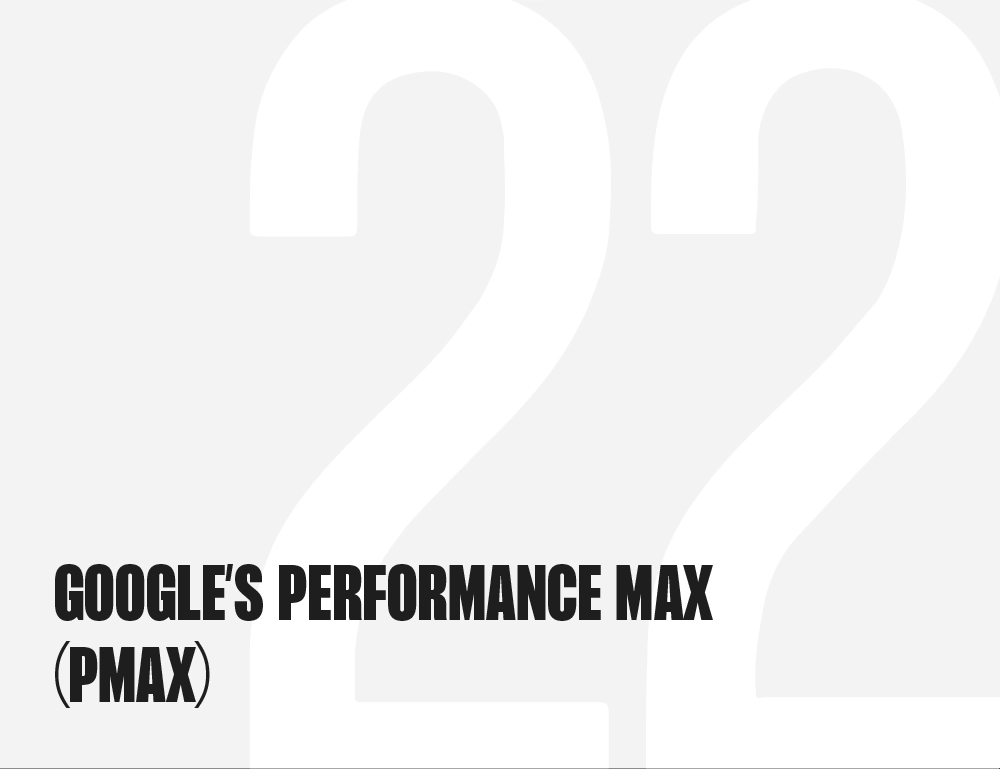PMax puts automation and conversion goals at the forefront, providing users with a more hands-off yet high-performing experience. After an initial setup process with your ads, PMax takes control and, with Google’s extensive data and real-time learning, strives to achieve your goals within your budget.
Performance Max campaigns place your business objectives front and center, allowing our automation to prioritize them above all else. This is essential for maximizing performance with Google Ads!
– Google
With PMax, advertisers can tap into a broader audience and achieve superior results by harnessing the full potential of automation and machine learning. While other Google ad types incorporate some machine learning and automation, PMax truly takes it to the next level, and we’ve witnessed remarkable results from it.
The Power of PMax
Performance Max campaigns enable advertisers to reach potential customers across an extensive range of Google networks, including:
- Display
- Google Search
- Shopping Ad Inventory
- Google Maps
- Discover Feed
- YouTube
- Gmail
The critical advantage of PMax lies in its ability to automatically optimize your ad creative, placements, and bids based on the real-time performance data it accumulates. By leveraging a wide array of user signals and Google’s potent algorithms, PMax ensures that your ads are displayed to the right audience at the right time and in the right places.
How Do Google PMax Campaigns Work?
Like Smart Campaigns and Responsive Display Ads, Google’s PMax campaigns are designed to take your assets and organize them based on audience insights, including which platforms to display them on. You specify your conversion goals, provide your assets, and set your budget, and Google essentially handles the rest! You can be as involved as you like and preview potential ad combinations. The assets you input include:
- Images
- Videos
- Logos
- Headlines
- Descriptions
- Audience signals
You group these into an “asset group” that PMax can draw from.
The primary distinctions between various ad campaign types and Performance Max (PMax) ads relate to the level of automation, ad placements, and targeting capabilities. Let’s delve into the key differences:
- AUTOMATION AND OPTIMIZATION
- Traditional Search, Display, Video, and Shopping Campaigns: These campaign types necessitate manual bidding, ad group creation, and targeting management. Although some automation is available through bid strategies and audience targeting, advertisers have more control over campaign setup and optimization.
- App Campaigns, Smart Campaigns, and Local Campaigns: These campaigns leverage advanced machine learning and automation to optimize ad performance. Advertisers provide assets and campaign goals, and Google’s algorithms handle the rest, including bidding, targeting, and ad placements.
- Performance Max (PMax) Ads: PMax takes automation to the next level. Advertisers only need to provide creative assets, a budget, and performance goals. Google’s machine-learning algorithms automate the entire campaign setup, optimization, and targeting. PMax ads utilize data from multiple Google networks to deliver suitable ads to the right users across various platforms.
- AD PLACEMENTS
- Traditional Search Campaigns: Ads appear on Google’s search engine results page when users search for specific keywords or phrases.
- Display Campaigns: Ads are displayed on websites, blogs, and apps within Google’s Display Network.
- Video Campaigns: Video ads are shown on YouTube and Google’s video partner sites.
- Shopping Campaigns: Product ads are featured on Google’s search results page.
- App Campaigns: App ads are displayed across Google Search, Google Play Store, YouTube, and other Display Network properties.
- Local Campaigns: Target users with ads across various Google networks to drive store visits and actions.
- Performance Max (PMax) Ads: PMax ads take a comprehensive approach, appearing across Google Search, Display, YouTube, and Discover, leveraging multiple networks and platforms to reach potential customers—and it’s automated, so you don’t need to set them up individually. Convenient!
- TARGETING AND REACH
- Traditional Campaigns: Advertisers have more control over audience targeting through keywords, interests, demographics, and placements.
- App, Smart, and Local Campaigns: Targeting is predominantly automated, with advertisers setting campaign goals to reach specific user groups.
- Performance Max (PMax) Ads: PMax utilizes a blend of automation and data from various Google networks to automatically optimize ad delivery and reach the most relevant audience.
- CAMPAIGN GOALS
- All Campaign Types: Advertisers can set specific campaign goals, such as website clicks, conversions, app installs, store visits, and more.
- Performance Max (PMax) Ads: PMax is entirely goal-oriented. It maximizes performance across various goals, ad formats, and channels using real-time learning and audience insights geared toward achieving your objectives.
While traditional campaign types offer more manual control over setup and targeting, PMax ads harness advanced automation and machine learning to optimize ad performance across all Google networks and platforms. PMax is designed to simplify advertising while delivering maximum results for advertisers. It makes it appealing for those seeking an efficient and effective advertising solution with less uncertainty.
7 Tips for Using PMax Effectively
- Align Your Campaign Goals: As PMax is strictly goal-driven, ensuring you have well-defined advertising objectives is essential. Whether boosting website traffic, driving conversions, or enhancing brand awareness, aligning your goals will aid Google’s complex algorithms in optimizing your ad delivery.
- Quality Ad Creative: While PMax is designed to automate creative optimization, the quality of your ad creative remains crucial. Craft visually appealing and compelling ads with clear CTAs that resonate with your target audience. Refer to Google’s Asset Group article for more information, and note that you will need a video.
- Utilize Audience Signals: Providing audience signals to Google provides the machine with valuable insights—suggestions on audiences you believe are most likely to respond favorably to your product or service.
- Leverage Performance Insights: Regularly monitor the performance of your PMax campaigns and gather insights on what’s effective and what’s not. Use this data to make informed decisions, optimize underperforming ads, and refine your overall strategy.
- Audience Segmentation: To maximize the impact of PMax campaigns, segment your audience based on relevant attributes such as interests, demographics, and behavior. Tailoring your messaging to specific audience segments can yield higher engagement rates.
- Budget Allocation: Distribute your budget strategically across different Google networks and platforms to effectively reach your audience. Keep your other campaigns active while testing PMax; you need time to assess results. Consider adjusting your budget allocation based on performance data to optimize campaign outcomes.
- Stay Updated with New Features: Google continually updates its advertising platform, introducing new features and enhancements. Stay informed about the latest advancements and embrace new functionalities to stay ahead of the competition.
Features of Google Performance Max
- Audience Signals: Instead of relying on audience segments or keywords, you can target by providing Google with “hints” through audience signals that identify user segments more likely to convert.
- Asset Groups: Performance Max shifts from ad formats to Asset Groups, which encompass a set of assets related to a single theme or audience. Multiple asset groups can be created per campaign.
- URL Expansion: Utilizing machine learning, the default URL Expansion feature selects a landing page based on customer insights. You can opt-out of this by using exclusions or specifying URLs you do not want to include. If there are pages you wish to exclude, ensure you inform Google.
- Reporting and Insights: PMax includes new reports that elucidate the workings of machine learning and the signals it utilizes. This data can assist you in adjusting your strategy.
Google’s Performance Max In Short
Google PMax ads represent a groundbreaking leap in the realm of online advertising. By harnessing the power of automation and machine learning, PMax campaigns can significantly enhance your advertising performance across all Google networks and platforms.
Engage, explore, and excel with Fluid22










